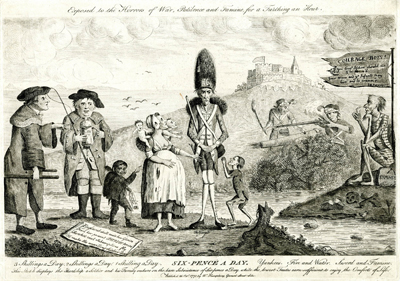Six Pence a Day
Six Pence a Day was published in 1775 by William Humphrey, and may be one of Gillray's earliest efforts. No less a person than Draper Hill, the dean of Gillray scholars, believes that this print "would be the logical antecedent of Gillray's style before he came heavily under the influence of [John Hamilton] Mortimer." Certainly the figure of Famine, the gaunt soldier, and the fat coachman all resemble later Gillray figures. And, of course the subject itself would have had particular urgency for Gillray as the son of a veteran.

© Trustees of the British Museum
The print is basically an argument against joining the military. As M. Dorothy George points out, in 1775 there were local subscriptions being raised to "provide comforts for soldiers and to increase the bounty paid to recruits." But with a revolution threatening in America, Gillray is, in effect, warning potential recruits that these blandishments are quite insufficient to offset the real costs of becoming a soldier.
It is, of course, a subject that Gillray would have been quite familiar with. His father (also James) had left a job as a blacksmith in Scotland to join the Queen's Dragoons in 1743 and lost an arm while fighting at Fontenoy during the war of the Austrian Succession. The elder James was fortunate in having long-standing relationship with the Scottish Calvinist Church, so when he was finally released from the hospital as a one-armed veteran, he was able to find employment as the Sexton of a Moravian Church, to get married, and to support a family. Other soldiers were no doubt less fortunate.
Like other satires derived from the emblem tradition, the visual organization of Gillray's print is rhetorical not dramatic, and corresponds to the three basic arguments against enlistment. To the left of the soldier, there are representatives of three professions: a chairman with one hand on the pole of his sedan chair, a coachman with his whip and a tankard, and a chimney sweep. Below them in the subscript are their respective daily wages: 3 shillings, 2 shillings, and 1 shilling. So even the lowly chimney sweep makes twice the salary of a soldier.
To the right of the soldier and across a stream are the representatives of what a soldier will really face: not just war (the American gunmen using the soldier as target practice), but also famine (embodied in the gaunt figure of famine itself), and pestilence and death (the skull and crossed bones).
And if low wages and threats to one's health and well-being were not sufficient deterrents, the center of the print shows us the poor soldier himself surrounded by his family—all of them starving, neglected, and desperate.+ This is the toll that soldiering exacts.
There is, of course, no dramatic explanation for the presence of the three sets of figures in an open space in sight of a fortress and overlooking the sea. And in a traditional emblem, there would be no need to explain. But Gillray is part of the evolution of satire from emblem to expression, and so he does his best to link them all by having the professionals point derisively at the soldier, the figure of famine beckon to him, and the military men fire at him.
+ Note: In featuring the soldier with his very pregnant wife Gillray may be remembering a similar duo in Hogarth's March to Finchley.
Sources and Reading
- Commentary from the British Museum on Six Pence a Day.
- Draper Hill, Mr. Gillray The Caricaturist, 1965
Comments & Corrections
NOTE: Comments and/or corrections are always appreciated. To make that easier, I have included a form below that you can use. I promise never to share any of the info provided without your express permission.